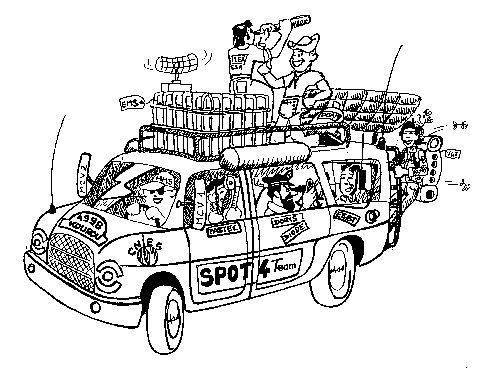What do earth observation satellites
do?
Main partners in the SPOT system
We only have one planet -- "Spaceship Earth". It is our sole heritage . . . all we have to pass on to our children. And it deserves to be treated as such.
In response to this challenge, increasingly sophisticated systems are being set up to monitor environmental change. Indeed, we are now moving from visual techniques restricted to our own field of view to the systematic evaluation of planetary resources.
Earth observation satellites capable of global monitoring and systematic inventorying come in two types : geostationary, at an orbital altitude of 36,000 km (which "hang" in the sky above a fixed point on the equator), and low-earth orbiting, or LEO satellites, at much lower altitudes, which move constantly relative to the earth below. SPOT satellites are of the low-earth orbiting type.
The system offers capabilities designed specifically for just such planetary management challenges :
The steerable strip-selection mirror at the entrance to each HRVIR can also be used to acquire oblique-viewing scenes, reducing the interval between successive opportunities for imagery acquisition to a maximum of five days at the equator, three days at 45° latitude, and even daily at latitudes above 70°. With SPOT 1 and SPOT 2 still in orbit, SPOT 4 will further reduce these intervals, since the number of imaging opportunities will be multiplied by three.
The spectral bands measured by the HRVIR instruments have been carefully selected to match the SPOT missions requirements, particularly for :
In addition to the two high-resolution HRVIR instruments (each offering resolutions of 10 et 20 metres), SPOT 4 also carries the "Vegetation" wide-angle, medium-resolution payload offering a swath width of 2,250 km and a resolution of 1 km. Indeed, the HRVIR and Vegetation missions are perfectly complementary. To ensure that all images register with each other, the instruments were designed from the outset to share key spectral bands and identical reference frames. Further, as they share the same platform, viewing conditions are always strictly identical. This means that analysts can reliably sample measurement data acquired by either type of instrument to gain maximum benefit from Vegetation's excellent revisit capability and the HRVIR's high spatial resolutions. The complementarity of Vegetation and HRVIR imagery offers unprecedented opportunities for reliable image interpretation at a variety of scales.
![]()
The SPOT 4 programme was funded primarily by France through budgetary allocations to the French space agency CNES. Additional funding has also been sought.
Since SPOT 1, each SPOT satellite has benefited from contributions (4% of programme costs each) by Belgium and Sweden via their respective space agencies. These funding efforts have, in turn, allowed Belgian and Swedish industrial firms to supply equipment for the satellites and ground segments.
Although Italy and Spain did not contribute to the funding of system development, each supplied certain subsystems used by the SPOT system and other space programmes undertaken in cooperation with France.
The European Union funded 43% of the development cost of the Vegetation system, the Vegetation payload being carried by the SPOT 4 satellite. The remainder of this programme is funded by Belgium (14%), Sweden (8%), Italy (1%) and France (34%). These figures include the funding of industrial products supplied by aerospace companies in the respective countries. Certain components of the SPOT family (satellite bus, additional SPOT 4 payloads) are thus thoroughly European. The choice of the European Ariane 40 launcher also generates work for European industrial firms.
SPOT 4 carries two technology demonstration payloads developed by the European Space Agency, Silex/Pastel and the ESBT S-band spread-spectrum transponder.
CNES is also cooperating with the Naval Research Laboratory, an American government organization, on the carrying and operational exploitation of the Poam III payload. For this payload, the NRL is paying CNES to include Poam III in the SPOT 4 payload and for its operation in orbit. French scientists will also have access to Poam III data for detailed analysis.

![]()
page updated on the 00-06-06